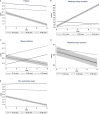Aging and the Change in Fatigue and Sleep - A Longitudinal Study Across 8 Years in Three Age Groups
- PMID: 29568279
- PMCID: PMC5852064
- DOI: 10.3389/fpsyg.2018.00234
Aging and the Change in Fatigue and Sleep - A Longitudinal Study Across 8 Years in Three Age Groups
Abstract
Fatigue is prevalent in the population and usually linked to sleep problems, and both are related to age. However, previous studies have been cross-sectional. The purpose of the present study was to investigate the trajectories of sleep and fatigue across 8 years of aging in a large group (N > 8.000) of individuals. A second purpose was to investigate whether fatigue trajectories would differ between age groups, and whether different trajectories of fatigue would be reflected in a corresponding difference in trajectories for sleep variables. Results from mixed model analyses showed that fatigue decreased across 8 years in all age groups, while sleep problems increased, non-restorative sleep decreased, weekend sleep duration decreased, and weekday sleep duration showed different patterns depending on age. Furthermore, the larger the decrease in fatigue, the larger was the increase in sleep duration across years, the lower was the increase of sleep problems, and the larger was the decrease of non-restorative sleep. The results suggest that aging has positive effects on fatigue and sleep and that these changes are linked.
Keywords: aging; longitudinal; restorative sleep; sleep duration; sleep quality.
Figures
References
LinkOut - more resources
Full Text Sources
Other Literature Sources


